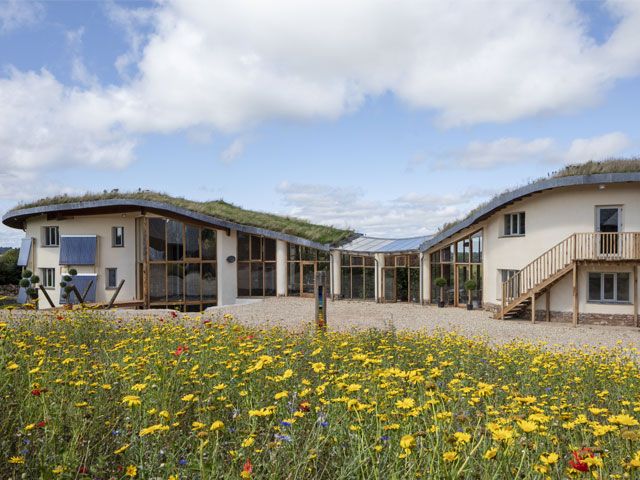Introduction to Cob Houses
Cob houses aren’t just homes; they’re whispers from the past, shaped into cozy, curved walls by hands eager for a touch of the earth. Crafted from simple materials—clay, sand, straw, and water—these structures stand as a testament to sustainable living and architectural creativity.
What is Cob?
Imagine grabbing a handful of earth, mixing it with a splash of water, a sprinkle of straw, and a dash of sand. That’s cob. This ancient building material is malleable yet durable, eco-friendly yet robust. The beauty of cob lies not just in its simplicity but also in its versatility. It molds to the maker’s will, allowing for organic shapes and personalized touches in construction.
A Brief History of Cob Construction
Cob building dates back thousands of years, rooted in some of the oldest civilizations across the globe. From the misty landscapes of the British Isles to the sun-drenched soils of Africa, cob has sheltered humanity from the elements, providing warm winters and cool summers. Traditionally, these homes were built community-wide, turning house construction into a communal, celebratory event.
Why Choose Cob Houses?
In an era buzzing with talk of sustainability, cob houses echo the principles of an eco-conscious lifestyle. But why choose cob over modern materials? Let’s break it down:
Environmental Benefits
Sustainability at Its Core: Cob is made from the soil beneath our feet—literally. It’s sustainable, requiring minimal processing and zero chemicals.
| Clay | Local soil | No transportation, natural material |
| Sand | Local soil | Abundant, natural |
| Straw | Local fields | Renewable, provides insulation |
| Water | Rainwater | Can be harvested locally, natural |
Cost-Effectiveness
Affordable Building: Forget expensive imports. Cob materials are often locally sourced and inexpensive. Moreover, the labor can be as cheap as your own sweat equity—a DIY dream.
Aesthetic and Design Flexibility
Craft Your Own Castle: Cob’s flexibility empowers you to create. Want a curved wall? A built-in bookshelf? Cob can do that. Each home is as unique as its builder, providing a creative freedom that prefabricated materials can’t match.
Why Cob?
| Low Carbon Footprint | Made from earth, emits little to no CO2 during construction |
| Cost-effective | Materials are cheap and often on-site |
| Aesthetically Pleasing | Natural look, blends with landscapes |
Cob houses represent more than just a return to basics—they’re a forward-thinking choice in a world that desperately needs sustainability. Whether you’re a builder, a dreamer, or someone who just cares about the planet, cob offers a way to live in harmony with our environment, crafting homes that are both beautiful and beneficial to the earth.
The Materials of Cob Construction
Cob construction has the charm of simplicity, using only a few natural materials blended together to create sturdy, beautiful homes. Here’s a closer look at each component and its role in the mixture:
Clay: The Binding Force
Source and Quality: The best clay for cob has a good balance of sand and clay particles. It should be plastic enough to mold but not so dense that it cracks easily. Local excavation sites or riverbanks are typical sources.
Why It Matters:
- Structural Integrity: Clay acts as the glue in cob, holding sand and straw together.
- Thermal Mass: Helps regulate indoor temperatures, keeping the house warm in winter and cool in summer.
Sand: The Framework
Types and Properties: Sand provides structural strength to cob. It’s crucial to use the right type—generally, sharp sand with angular grains is preferred over smooth, round beach sand.
Benefits:
- Prevents Shrinkage: Reduces the clay’s tendency to crack during drying.
- Adds Bulk: Gives body to the mix, making the walls sturdy.
Straw: The Secret Ingredient
Best Practices for Use: Straw in cob acts as reinforcement, much like rebar in concrete. It helps control cracking during drying and increases the tensile strength of the walls.
Key Points:
- Length and Quality: Long, robust strands of straw are ideal as they interlock well within the mix.
- Renewable Resource: Easily sourced from local farms, straw is a sustainable choice that adds organic insulation to cob walls.
Water: The Catalyst
Importance of Moisture Content: Water activates the clay, allowing it to bond with sand and straw. The right amount of water is crucial—a mix that’s too wet will slump, while too dry won’t bind properly.
Managing Water Use:
- Source Locally: Collect rainwater or use recycled water to minimize the ecological footprint.
- Consistency Is Key: Aim for a mix that holds together well but isn’t soggy.
Designing Your Cob House
Designing a cob house is both an art and a science. It’s about balancing aesthetics with practical considerations like climate, location, and functionality.
Planning for Climate and Location
Adapting to the Environment: Cob houses are excellent at climate control, but they must be designed according to local weather conditions. In wetter climates, for instance, good drainage and a robust roof are crucial to protect the walls from moisture.
Incorporating Passive Solar Design
Harnessing the Sun: Position windows and walls to maximize solar gain in winter and minimize heat during summer. Properly designed overhangs can provide shade when needed, enhancing the home’s energy efficiency.
Aesthetic Possibilities: Curves and Niches
Creative Freedom: One of the joys of building with cob is the ability to sculpt your home. Curved walls, built-in niches for storage or decoration, and other custom features can be easily integrated into the design.
Innovative Design Ideas:
- Sculptural Elements: Incorporate artistic details directly into the structure.
- Custom Layouts: Design open floor plans or cozy nooks according to your lifestyle.
In cob house design, the only limit is your imagination. With thoughtful planning and a creative spirit, you can craft a space that is not only sustainable and sturdy but also uniquely yours, reflecting your personal style and values.
The Foundation for Cob Houses
Choosing the right foundation for a cob house is crucial for ensuring the longevity and stability of the structure. Cob’s substantial weight requires a solid base that can prevent settling and moisture issues.
Choosing the Right Foundation
Options and Considerations: The choice of foundation depends largely on soil type and climate. Common options include:
- Rubber Tired Foundation: Using recycled car tires filled with compacted earth provides a strong, eco-friendly base.
- Stone Foundation: A traditional choice that offers excellent drainage and stability.
- Concrete Foundation: Although less eco-friendly, it provides unmatched durability and moisture resistance.
Key Factors to Consider:
- Drainage: Good drainage is essential to protect cob walls from moisture.
- Frost Line: The foundation must extend below the frost line to prevent shifting during freeze-thaw cycles.
Preventing Moisture Ingress
Moisture Management Strategies: Effective moisture management is critical in cob construction to maintain the integrity and comfort of the home.
- Damp-proof Course (DPC): A physical barrier, like a layer of slate or a commercial damp-proof membrane, can prevent capillary action from drawing moisture up into the cob walls.
- Elevated Foundation: Raising the foundation several inches above the ground level can help keep the base of the walls dry.
Building Techniques for Cob
Constructing a cob house involves traditional techniques that have been refined over centuries, coupled with modern insights to improve durability and efficiency.
Step-by-Step Building Process
Constructing a Cob Wall:
- Mixing the Cob: Combine clay, sand, straw, and water in the right proportions. The mixture should be kneadable but not overly wet.
- Laying the Cob: Apply the cob in layers, known as ‘lifts’, ensuring each layer is compact and well bonded to the one below.
- Sculpting the Walls: As the walls rise, shape them with hands or tools, integrating artistic elements or functional features like niches.
- Drying: Allow the walls to dry slowly, protecting them from rain and extreme sun. This can take several weeks depending on the weather.
Tips for Achieving Strong and Durable Walls
Enhancing Wall Integrity:
- Controlled Drying: Avoid rapid drying which can lead to cracking. Use tarps or shades to regulate exposure to elements.
- Strategic Reinforcement: Insert wooden dowels or bamboo poles at strategic points to help support larger structures or load-bearing walls.
- Regular Maintenance: Address small cracks or erosions promptly to maintain the structural integrity over time.
Building a cob house is a hands-on, deeply personal process that rewards patience and creativity. With the right techniques and attention to detail, a cob home can last for generations, offering a sustainable, environmentally friendly living space.
Cob House Architectural Features
When designing a cob house, the architectural features you choose can significantly enhance both the functionality and aesthetic appeal of the home. Cob’s natural versatility allows for the integration of unique elements that make each house distinct.
Windows and Doors: Installation in Cob Walls
Integrating Openings: Properly integrating windows and doors into cob walls is crucial for structural integrity.
- Frames and Supports: Use sturdy wooden or metal frames to reinforce the openings.
- Lintels: Install lintels above windows and doors to distribute the weight and prevent the cob from collapsing.
Design Tips:
- Positioning for Light and Heat: Place windows strategically to maximize natural light and passive solar heating.
- Aesthetic Alignment: Align windows and doors for visual harmony and balance in the building’s overall design.
Creating Lofts and Multi-story Structures
Building Upwards: While cob is predominantly used for single-story structures due to its weight, innovative techniques can allow for additional levels or loft spaces.
- Internal Supports: Use internal wooden or steel beams to support additional weight without putting stress on the cob walls.
- Design Considerations: Ensure the structure’s foundation and lower walls are reinforced to handle the additional load.
Interior Design Considerations
Blending Function with Form:
- Built-in Furniture: Cob’s malleability allows for built-in shelves, seats, or even fireplaces, reducing the need for additional furniture.
- Texture and Color: Take advantage of cob’s texture for a rustic look or apply natural plasters for a smoother, more colorful finish.
Modern Cob House Innovations
As building technologies evolve, so do the techniques and materials used in cob construction, allowing for modern conveniences and better energy efficiency while maintaining environmental integrity.
Integration of Modern Amenities
Modern Living with Traditional Materials:
- Electrical and Plumbing: Integrate modern utilities during the construction phase, embedding conduits and plumbing in the walls.
- Heating and Cooling Systems: Incorporate modern heating solutions like radiant floor heating or design for natural ventilation.
Combining Cob with Other Sustainable Practices
Enhancing Eco-friendliness:
- Green Roofs: Install a green roof to add insulation and reduce runoff.
- Solar Panels: Utilize solar panels to provide renewable energy, making the home more self-sufficient.
Innovative Material Combinations:
- Hybrid Structures: Combine cob with timber framing or straw bale construction for improved structural diversity and insulation.
The evolution of cob house construction embraces both tradition and innovation, offering a path toward sustainable living that does not sacrifice the comforts of modern technology. By integrating these modern elements, cob houses can meet contemporary needs while still providing a low-impact, sustainable housing solution.
Common Misconceptions about Cob Houses
Despite their historical and environmental benefits, cob houses often face misconceptions that can deter people from considering them as a viable housing option. Here are some common myths debunked:
Myth 1: Cob Houses Are Not Durable
The Reality: When properly maintained, cob houses can last for centuries. Examples abound in Europe, where cob homes several hundred years old are still inhabited today.
Myth 2: Cob Is Only Suitable for Warm Climates
The Reality: Cob has excellent thermal mass, meaning it can store and radiate heat efficiently. With proper design, such as orientation and insulation, cob houses can be comfortable in diverse climates, including colder regions.
Myth 3: Cob Construction Is Labor-Intensive and Impractical
The Reality: While cob construction does require physical effort, its labor needs are often seen as a community-building opportunity. Additionally, the use of local, natural materials can significantly reduce costs and environmental impact.
Myth 4: Cob Houses Are Prone to Moisture Problems
The Reality: Cob can be susceptible to moisture if not properly protected and maintained. However, with correct design features like good foundations, roof overhangs, and plastering, cob houses can remain dry and sturdy.
Case Study
The “Dingle Dell” in Devon, UK
Overview: Built using traditional methods, this cob house demonstrates the durability and comfort of cob construction in a wet, temperate climate.
Achievements: With walls over two feet thick and a thatched roof, the house remains warm in winter and cool in summer, emphasizing cob’s natural insulation properties.
The Future of Cob in Sustainable Architecture
Looking ahead, cob’s role in sustainable architecture appears promising and expanding due to its low environmental impact and adaptability to various climates and cultures.
Innovations and Trends
- Technological Integration: As sustainable practices evolve, cob houses are increasingly incorporating green technologies like solar panels and eco-friendly water systems.
- Hybrid Building Techniques: Combining cob with other sustainable building methods, such as timber framing or straw bale, enhances structural integrity and insulation.
Advocacy and Education
- Building Codes and Regulations: Efforts are ongoing to include cob in mainstream building codes, making it easier for people to choose cob legally and confidently.
- Workshops and Courses: Increasing availability of educational resources and hands-on workshops is demystifying cob construction, making it accessible to more DIY builders and professionals.
Conclusion
The future of cob in architecture is not just about continuing a tradition but evolving it. By embracing both ancient methods and modern innovations, cob can play a crucial role in the global movement towards more sustainable, resilient, and human-centric housing solutions.
If you want o learn about our consultancies in Portuguese language, click here.
The post The Future of Cob: Sustainable Building for Tomorrow’s World appeared first on UGREEN.




